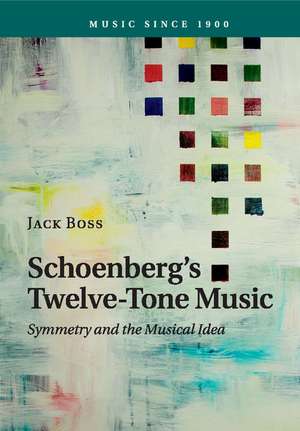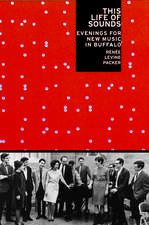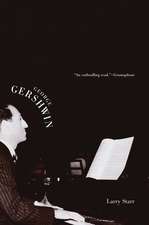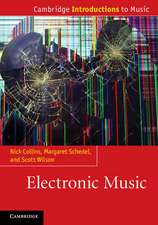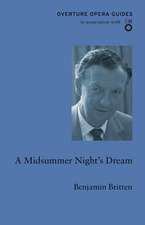Schoenberg's Twelve-Tone Music: Symmetry and the Musical Idea: Music since 1900
Autor Jack Bossen Limba Engleză Paperback – 27 iul 2016
| Toate formatele și edițiile | Preț | Express |
|---|---|---|
| Paperback (1) | 281.99 lei 6-8 săpt. | |
| Cambridge University Press – 27 iul 2016 | 281.99 lei 6-8 săpt. | |
| Hardback (1) | 886.07 lei 6-8 săpt. | |
| Cambridge University Press – oct 2014 | 886.07 lei 6-8 săpt. |
Din seria Music since 1900
-
 Preț: 219.42 lei
Preț: 219.42 lei -
 Preț: 239.17 lei
Preț: 239.17 lei -
 Preț: 287.07 lei
Preț: 287.07 lei -
 Preț: 445.37 lei
Preț: 445.37 lei -
 Preț: 179.45 lei
Preț: 179.45 lei -
 Preț: 365.19 lei
Preț: 365.19 lei - 11%
 Preț: 439.08 lei
Preț: 439.08 lei -
 Preț: 236.02 lei
Preț: 236.02 lei -
 Preț: 281.88 lei
Preț: 281.88 lei -
 Preț: 291.52 lei
Preț: 291.52 lei - 14%
 Preț: 894.06 lei
Preț: 894.06 lei -
 Preț: 292.29 lei
Preț: 292.29 lei -
 Preț: 291.69 lei
Preț: 291.69 lei -
 Preț: 285.93 lei
Preț: 285.93 lei -
 Preț: 327.30 lei
Preț: 327.30 lei -
 Preț: 243.31 lei
Preț: 243.31 lei -
 Preț: 206.57 lei
Preț: 206.57 lei -
 Preț: 322.89 lei
Preț: 322.89 lei -
 Preț: 283.03 lei
Preț: 283.03 lei -
 Preț: 283.52 lei
Preț: 283.52 lei -
 Preț: 274.66 lei
Preț: 274.66 lei -
 Preț: 285.75 lei
Preț: 285.75 lei -
 Preț: 288.62 lei
Preț: 288.62 lei -
 Preț: 304.07 lei
Preț: 304.07 lei -
 Preț: 326.15 lei
Preț: 326.15 lei -
 Preț: 293.03 lei
Preț: 293.03 lei -
 Preț: 290.38 lei
Preț: 290.38 lei -
 Preț: 292.07 lei
Preț: 292.07 lei
Preț: 281.99 lei
Nou
Puncte Express: 423
Preț estimativ în valută:
53.97€ • 56.13$ • 44.55£
53.97€ • 56.13$ • 44.55£
Carte tipărită la comandă
Livrare economică 14-28 aprilie
Preluare comenzi: 021 569.72.76
Specificații
ISBN-13: 9781107624924
ISBN-10: 1107624924
Pagini: 466
Ilustrații: 221 music examples
Dimensiuni: 171 x 245 x 25 mm
Greutate: 0.74 kg
Editura: Cambridge University Press
Colecția Cambridge University Press
Seria Music since 1900
Locul publicării:New York, United States
ISBN-10: 1107624924
Pagini: 466
Ilustrații: 221 music examples
Dimensiuni: 171 x 245 x 25 mm
Greutate: 0.74 kg
Editura: Cambridge University Press
Colecția Cambridge University Press
Seria Music since 1900
Locul publicării:New York, United States
Cuprins
1. Musical idea and symmetrical ideal; 2. Suite for Piano, Op. 25: varieties of idea in Schoenberg's earliest twelve-tone music; 3. Woodwind Quintet, Op. 26: the twelve-tone idea reanimates a large musical form; 4. Three Satires, Op. 28, #3: the earliest example of the 'symmetrical ideal' in a (more or less) completely combinatorial context; 5. Piano Piece, Op. 33a: the 'symmetrical ideal' conflicts with and is reconciled to row order; 6. Fourth String Quartet, Op. 37, mvt. I: two motives give rise to contrasting row forms, meters, textures and tonalities (and are reconciled) within a large sonata form; 7. Moses und Aron: an incomplete musical idea represents an unresolved conflict between communicating with God using word or image; 8. String Trio, Op. 45: a musical idea (and a near-death experience) is expressed as a conflict between alternative row forms.
Recenzii
'Future scholars interested in following Boss's lead will benefit immeasurably from his careful analyses, his synthesis of previous scholarship, and, perhaps most of all, the provocative questions his work raises.' Zachary Bernstein, Journal of Music Theory
'Densely informative and richly detailed, Jack Boss's monograph on Schoenberg's twelve-tone music is the product of an impressive thirteen years of analytical work, itself drawing on a career-spanning engagement with Schoenberg's music. … The sincerity of the project is unquestionable and Jack Boss communicates both expertise and laudable passion.' Andrew J. Chung, Current Musicology
'Boss's groundbreaking book provides a new and illuminating methodology for understanding, exploring, and appreciating Schoenberg's music.' Joe Argentino, Music Theory Online
'Densely informative and richly detailed, Jack Boss's monograph on Schoenberg's twelve-tone music is the product of an impressive thirteen years of analytical work, itself drawing on a career-spanning engagement with Schoenberg's music. … The sincerity of the project is unquestionable and Jack Boss communicates both expertise and laudable passion.' Andrew J. Chung, Current Musicology
'Boss's groundbreaking book provides a new and illuminating methodology for understanding, exploring, and appreciating Schoenberg's music.' Joe Argentino, Music Theory Online
Notă biografică
Descriere
Jack Boss presents detailed analyses of Arnold Schoenberg's twelve-tone pieces, bringing the composer's 'musical idea' - problem, elaboration, solution - to life.
